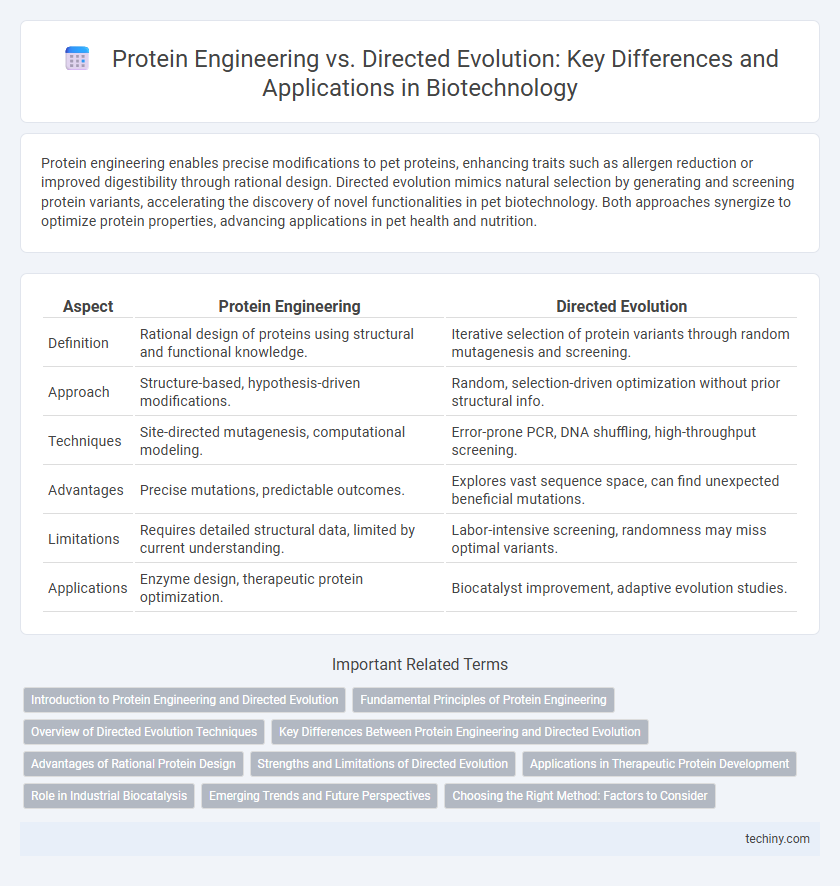Protein engineering enables precise modifications to pet proteins, enhancing traits such as allergen reduction or improved digestibility through rational design. Directed evolution mimics natural selection by generating and screening protein variants, accelerating the discovery of novel functionalities in pet biotechnology. Both approaches synergize to optimize protein properties, advancing applications in pet health and nutrition.
Table of Comparison
| Aspect | Protein Engineering | Directed Evolution |
|---|---|---|
| Definition | Rational design of proteins using structural and functional knowledge. | Iterative selection of protein variants through random mutagenesis and screening. |
| Approach | Structure-based, hypothesis-driven modifications. | Random, selection-driven optimization without prior structural info. |
| Techniques | Site-directed mutagenesis, computational modeling. | Error-prone PCR, DNA shuffling, high-throughput screening. |
| Advantages | Precise mutations, predictable outcomes. | Explores vast sequence space, can find unexpected beneficial mutations. |
| Limitations | Requires detailed structural data, limited by current understanding. | Labor-intensive screening, randomness may miss optimal variants. |
| Applications | Enzyme design, therapeutic protein optimization. | Biocatalyst improvement, adaptive evolution studies. |
Introduction to Protein Engineering and Directed Evolution
Protein engineering involves designing and constructing new proteins with enhanced or novel functions through rational design based on structural and functional knowledge. Directed evolution mimics natural selection by generating protein variants via random mutagenesis and selecting those with desired traits, accelerating the development of improved biomolecules. Both techniques are pivotal in biotechnology for creating enzymes with optimized activity, stability, and specificity for industrial, medical, and research applications.
Fundamental Principles of Protein Engineering
Protein engineering relies on rational design to modify protein structures based on detailed knowledge of amino acid sequences and three-dimensional conformations, enabling precise control over functional outcomes. Directed evolution mimics natural selection by generating diverse protein variants through random mutagenesis and selecting those with improved traits, often without prior structural information. The fundamental principles of protein engineering emphasize structure-function relationships, computational modeling, and site-specific mutations to achieve targeted enhancements in enzyme activity, stability, or specificity.
Overview of Directed Evolution Techniques
Directed evolution techniques mimic natural selection in the lab to generate proteins with enhanced or novel functions by iterative rounds of mutation and selection. Key methods include error-prone PCR, DNA shuffling, and site-saturation mutagenesis, which introduce genetic diversity for screening improved variants. These approaches accelerate the development of enzymes, antibodies, and other biocatalysts with tailored properties for pharmaceuticals, industrial applications, and synthetic biology.
Key Differences Between Protein Engineering and Directed Evolution
Protein engineering involves the rational design and modification of protein structures based on known sequences and functions, allowing precise control over specific amino acid changes. Directed evolution mimics natural selection in the laboratory by generating diverse protein variants through random mutagenesis and screening for desired traits, enabling the discovery of improved or novel functions without prior structural knowledge. The key difference lies in protein engineering's reliance on structural insights for targeted modifications versus directed evolution's empirical approach to optimizing protein function through iterative mutation and selection cycles.
Advantages of Rational Protein Design
Rational protein design offers precise control over amino acid substitutions by leveraging detailed structural and functional information, enabling targeted modifications that enhance enzyme specificity, stability, or activity. This approach reduces the need for extensive screening compared to directed evolution, accelerating the development of proteins with desired properties. Utilizing computational tools and molecular modeling, rational design facilitates the prediction and creation of novel proteins tailored to specific biotechnological applications.
Strengths and Limitations of Directed Evolution
Directed evolution excels in generating novel protein variants by mimicking natural selection, allowing the rapid improvement of enzyme activity, stability, and specificity without requiring detailed structural knowledge. However, its limitations include the need for high-throughput screening methods to identify beneficial mutations and potential bottlenecks in exploring vast mutational spaces. Despite these challenges, directed evolution remains a powerful tool in protein engineering for optimizing proteins with enhanced functional traits.
Applications in Therapeutic Protein Development
Protein engineering enables precise modification of therapeutic proteins to enhance stability, binding affinity, and reduce immunogenicity, facilitating the design of targeted biologics such as monoclonal antibodies and enzyme replacements. Directed evolution accelerates the discovery of novel protein variants by iterative cycles of mutation and selection, optimizing functions like catalytic efficiency and specificity without requiring detailed structural knowledge. Combining both approaches maximizes therapeutic potential, improving biopharmaceutical efficacy and safety profiles in treatments for cancer, genetic disorders, and infectious diseases.
Role in Industrial Biocatalysis
Protein engineering employs rational design techniques to create enzymes with enhanced stability and specificity tailored for industrial biocatalysis, accelerating the development of efficient catalytic processes. Directed evolution mimics natural selection by iterative rounds of mutation and screening, generating enzymes with improved activity and resistance to harsh industrial conditions. Combining both approaches optimizes enzyme functionality, driving cost-effective and sustainable biocatalytic manufacturing in pharmaceuticals, biofuels, and specialty chemicals.
Emerging Trends and Future Perspectives
Protein engineering relies on rational design using computational modeling and structural data to create proteins with desired functions, while directed evolution mimics natural selection by generating diversity and selecting improved variants. Emerging trends include integrating machine learning algorithms with high-throughput screening to accelerate the optimization process and expanding the use of non-natural amino acids to enhance protein functionalities. Future perspectives emphasize combining these approaches within automated platforms to develop highly efficient biocatalysts for applications in medicine, industrial biotechnology, and environmental sustainability.
Choosing the Right Method: Factors to Consider
Choosing the right method between protein engineering and directed evolution depends on factors such as the desired precision, time constraints, and functional goals. Protein engineering offers rational design approaches ideal for specific mutations based on known structures, while directed evolution excels in exploring vast sequence space without prior structural knowledge. Consider project complexity, available resources, and target protein characteristics to optimize results in biotechnological applications.
Protein Engineering vs Directed Evolution Infographic

 techiny.com
techiny.com